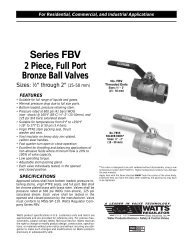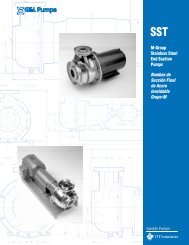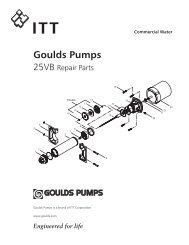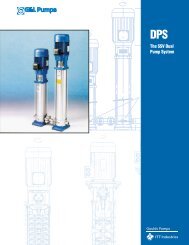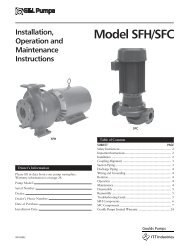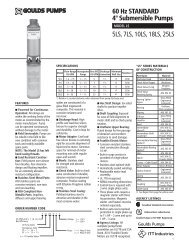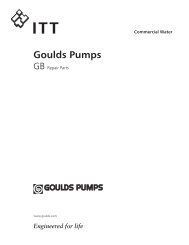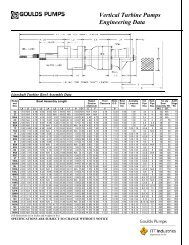Sewage Pump Guide Rail Systems Installation & Operation Manual
Sewage Pump Guide Rail Systems Installation & Operation Manual
Sewage Pump Guide Rail Systems Installation & Operation Manual
You also want an ePaper? Increase the reach of your titles
YUMPU automatically turns print PDFs into web optimized ePapers that Google loves.
OPERATION<br />
WARNING<br />
DO NOT LIFT, CARRY OR HANg<br />
PUMP BY THE ELECTRICAL CABLE.<br />
DAMAgE TO THE ELECTRICAL<br />
CABLE CAN CAUSE SHOCK, BURNS<br />
OR DEATH.<br />
Hazardous voltage<br />
can shock, burn or<br />
cause death.<br />
Raise and lower the pump in the containment area using<br />
the lifting cable attached to the system's quick disconnect<br />
for the A10-12, A10-2015 or A10-20, and to the pump's<br />
lifting eye/strap for the A10-30, A10-40 and A10-60. DO<br />
NOT use electrical cable and DO NOT damage the electrical<br />
cables while raising and lowering unit. A10-40 and<br />
A10-60 units can be used in conjunction with a lifting<br />
bail (part # ABAIL2).<br />
To ensure full prime, lower the pump(s) on the slide rails<br />
until fully submerged. Do not engage pump discharge to<br />
the rail discharge connection. Jog the pump motor, one<br />
to two seconds, to purge air from pump casing. Lower<br />
the pump and engage with base.<br />
While the slide rail system mating surfaces are self cleaning<br />
and contain no sealing devices, a check for leaks at<br />
the initial installation and after each pump removal or<br />
installation is recommended.<br />
While manually controlling the pump and the containment<br />
area inflow, using each pump independently, pump<br />
down the containment area.<br />
Observe the pump, piping and slide rail base discharge<br />
connections for leaks.<br />
If leaks are present, reset the pump and slide rail mating<br />
surfaces and recheck. If this fails to stop the leak,<br />
the pump should be removed and the necessary adjustments<br />
made to correct the leak. Leakage will cause longer<br />
operation time, higher costs and may lead to premature<br />
failure of slide rail base discharge connection.<br />
6<br />
WARNING<br />
Wire rope WILL FAIL if worn-out, overloaded, misused,<br />
damaged, improperly maintained or abused.<br />
Wire rope failure may cause serious injury or death!<br />
Protect yourself and others:<br />
• ALWAYS INSPECT wire rope for, WEAR, DAMAGE or<br />
ABUSE BEFORE USE.<br />
• NEVER USE wire rope that is WORN-OUT, DAMAGED<br />
or ABUSED.<br />
• NEVER OVERLOAD a wire rope.<br />
• INFORM YOURSELF: Read and understand<br />
manufacturer’s literature or “Wire Rope and Wire<br />
Rope Sling Safety Bulletin”.*<br />
• REFER TO APPLICABLE CODES, STANDARDS and<br />
REGULATIONS for INSPECTION REQUIREMENTS and<br />
REMOVAL CRITERIA.*<br />
* For additional information or the BULLETIN, ask your<br />
employer or wire rope supplier.<br />
© 1993, Wire Rope Technical Board Form No. 193<br />
WORKINg LOAD LIMIT<br />
Cable A10-12, A10-20 and A10-2015<br />
The working load limit is based on a load being uniformly<br />
applied in a straight line pull.<br />
3 /16" 7x19 304SS Air Craft Cable WLL = 740 lbs.<br />
Do not exceed safe working load limits.<br />
WARNINgS<br />
Inspection<br />
Wire ropes, cables and attachments must all be inspected<br />
regularly for visible damage or distortion, elongation,<br />
corrosion, cracks, nicks or abrasion which may cause<br />
failure or reduce the original strength or ability of the<br />
products to perform safely. User must determine whether<br />
future use of the wire rope or cable would constitute a<br />
safety hazard to life or property.<br />
Safety<br />
Refer to WARNING and CAUTION labels prior to use.<br />
Keep out from under any raised loads and keep out of<br />
the line of force of any load.<br />
Do not use wire ropes or cables for any purpose other<br />
than which it was intended.<br />
AVOID SHOCK LOADS<br />
Warnings<br />
Failure to use wire ropes or cables properly may cause<br />
loads to slip or fall.<br />
Failure to read, understand and follow these instructions<br />
may cause death or serious injury.<br />
Do not exceed safe working load limits.



